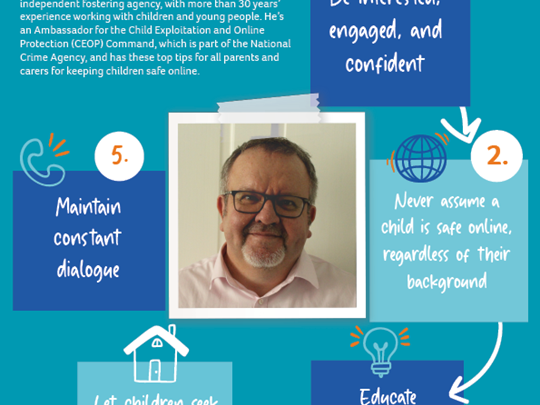Mark Briggs is a Team Manager at Fostering People with more than 30 years’ experience working with children and young people. He’s an ambassador for Child Exploitation and Online Protection (CEOP) Command, which is part of the National Crime Agency, and has these top tips for all parents and guardians to keep kids safe online.

The internet is an amazing resource for children and young people. It provides a space for them to explore their interests, socialise, do homework and stay up-to-date with what’s going on in the world. But, having so much information – and so many people – at their fingertips can also pose serious risks, with the internet often being a playground for those with harmful intentions.
Children and young people in care are especially vulnerable to online exploitation – this could be sexual, drug-related, or grooming – but the dangers of easy access to harmful content apply to every single child, teenager and young person. In fact, these risks can even spill into our adult lives if we don’t tackle them early on. It’s crucial that foster parents, parents, and all guardians take internet safety seriously and put safeguards in place to protect their children from accessing harmful content.
Here are our top tips to help you navigate online threats and keep young people safe from harm.
6 Top Tips for Navigating Online Threats & Keeping Young People Safe
1. Be interested, engaged, and confident
This is my absolute number one top tip, I cannot stress enough that if you don’t feel confident and show interest the young people around you will know and this is where it gets dangerous. You need to understand the internet – how it works, its different uses, and the types of technology that provide access to it. If they don’t feel confident in your understanding, they will not come to you with any questions and concerns.
You can improve your knowledge of the internet by engaging with the online world and educating yourself about the latest trends and technology. This way, children and young people will be more likely to come to you for help if they encounter problems, knowing you’ll understand how to support them.
It’s important to build trust by showing a genuine interest in what your kids are looking at online and encouraging open conversations to show them you’re a safe space for talking about online safety. If they find a funny video online, watching it with them could help you start a discussion about online safety and help bridge the digital gap.
2. Never assume a child is safe online, regardless of their background
Children in care are at a higher risk online, but the same dangers apply to all kids. Children today are curious and tech-savvy, but so many online threats are hidden. Online predators can easily manipulate a child’s need for validation and attention, by which point it’s too late.
Internet safety is an ongoing issue that can’t be solved with a one-time conversation, and you should never assume that your child is safe online. You might have parental controls and boundaries about the internet within the home, but children can still access harmful content through their friends’ phones, school computers, and public Wi-Fi. Some kids know how to bypass parental controls and could use secret accounts without your knowledge.
3. Educate children before it’s too late
When it comes to internet safety we need to be proactive, not reactive.
Unlike first aid, which we can use to treat an injury, kids need to know where online risks are before they find themselves in hot water. Children and teenagers need to be confident in identifying and avoiding dangers before sending the photo or running the errand. It’s a lot harder to deal with if they’re already in contact with dangerous people online. It’s a slippery slope.
That’s why it’s vital that kids feel like adults in their lives get the internet; it’ll make it easier for you to talk to them about staying safe online and for them to ask for help.
4. Let kids seek help without fear of judgement
At Fostering People I’ve run internet safety sessions with people who give a flat and firm no when it comes to social media and general internet usage. But taking it away only makes it more appealing and essentially alienates you from productive, safe, and helpful conversations with the children and young people in your care.
Saying no or judging children or young people for their online lifestyles will only push them further away. By showing them that you can help and support them without belittling or condemning will encourage them to come forward when they need help. Judgement will only push them further away and possibly into even greater danger.
Online predators take advantage of kids who feel misunderstood or unheard, saying the things they want to hear and luring them into a false sense of security. Once a predator gains a child’s trust, they can start grooming them and pushing them into doing things they don’t really want to do – like sending sexual images or viewing violent and extremist content, it can even result in blackmail.
It can be really challenging for adults to admit they need to learn more about the internet, but it’s the only way you can really help kids enjoy the internet safely.
5. Maintain a constant dialogue
Talking about online safety once will not solve the problem.
The internet changes faster than most of us can keep up with, so keeping the conversation flowing and regular check-ins are vital to maintaining a safe online presence. Ask questions often instead of assuming a child will come to you with a concern.
Make it a regular chat around the table or on the way to school so it’s accessible and doesn’t feel like a big deal.
6. Lessons we can learn from Axel Rudakubana’s case
Foster parents, parents, and all guardians need to act now to stop another child or young person from getting caught up in the wrong part of the internet. Axel Rudakubana’s actions were horrific, but it all started with the online interactions that led to his radicalisation, and ultimately, he is another young person whose life has been ruined by harmful online content. You don’t have to be isolated or feel alone to be groomed, sometimes you just need to be seen or heard and sometimes you might be in the wrong place at the wrong time.
Whether it’s extremism, sexual exploitation, drugs, violence, or terrorism, online predators use the same manipulation tactics – and the fallout is always bad, both for the children they manipulate and the people who get hurt because of it.
Come to some online safety training with Fostering People
The internet is a minefield, don’t worry if you feel a bit overwhelmed there’s lots to learn but we can really help to break it down for you.
Not sure how to keep your kids safe online? Get in touch for more information.
Usually, our sessions are just for foster parents, but we’re planning to run some sessions outside of fostering to give all adults a better understanding of the dangers of the internet, keeping the whole family safe.
